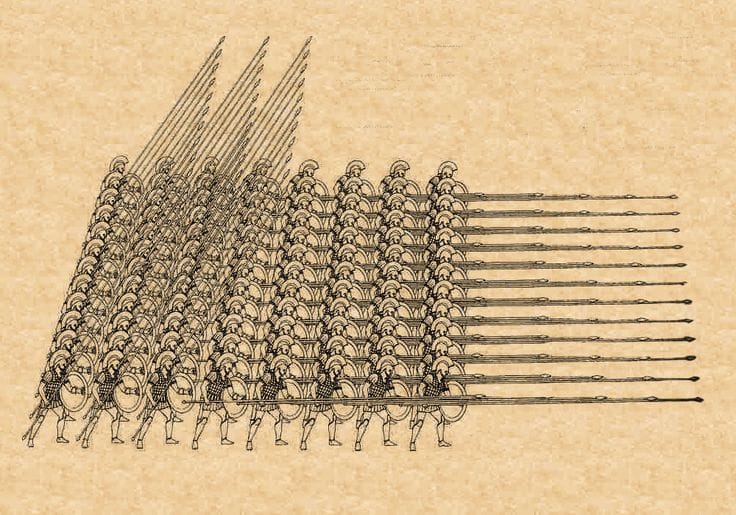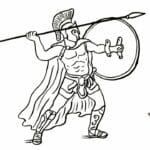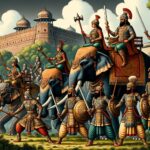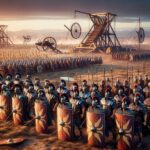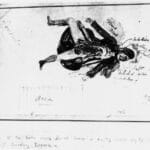Unmasking the Spartan Military Machine
Hey there, history buffs! Ever wondered how the Spartans, with their relatively small population, managed to become the most formidable military force in ancient Greece? The answer, in part, lies in their ingenious battle formations, forever immortalized in ancient drawings. These visual relics offer a fascinating glimpse into the tactical genius that made the Spartans legendary warriors. Let’s decode these ancient blueprints and unlock the secrets behind their battlefield dominance.
Cracking the Code: The Spartan Phalanx Revealed
Imagine holding a piece of papyrus etched with figures from millennia ago – a window into the Spartan art of war. One formation, in particular, stands out: the mighty phalanx. More than just a cluster of soldiers, the phalanx was a carefully orchestrated symphony of bronze and brawn.
The Anatomy of an Unbreakable Wall
The phalanx was essentially a tight rectangle of heavily armed hoplites—citizen-soldiers who represented the Spartan elite. Each hoplite was equipped with:
- Dory: A 7-9 foot spear, the dory was the phalanx’s primary offensive weapon, designed for thrusting over the shields of the front ranks.
- Aspis: This large, round shield, called a “hoplon,” was critical. Made of wood and bronze, it protected the individual soldier while its overlapping design created a near-impenetrable barrier for the entire formation.
- Xiphos: A short sword used for close-quarters combat if the dory broke or ranks clashed, proving the Spartans were prepared for any scenario.
- Armor: Bronze breastplates, helmets, and greaves provided crucial protection, though at the cost of significant weight.
This combination of disciplined warriors and heavy equipment was formidable, but the phalanx’s true power lay in its coordinated movements.
Key Maneuvers of the Spartan Phalanx
The drawings depict more than just static formations; they hint at the Spartan’s dynamic battle tactics:
- The Line Advance: Picture a human battering ram, advancing with relentless, crushing momentum. That was the phalanx on the move, their shields interlocked, pressing forward with mechanical precision.
- The Shield Wall: Imagine facing a wall of bronze, impenetrable and unforgiving. Each hoplite’s shield protected not only himself but also his comrade to the left, forming a shield wall that must have been terrifying to behold.
- The Spear Wall: A bristling array of spears, jutting out from behind the shield wall like a porcupine’s quills, awaited any enemy foolish enough to charge.
Thinking Outside the Box Formation: Adaptability and Limitations
The Spartans were not slaves to a single tactic. Archaeological evidence and historical accounts suggest they employed strategic flexibility:
- Flanking Maneuvers: Some drawings suggest Spartans used terrain to their advantage. They might have utilized hills or forests to conceal their movements, launching surprise attacks on the enemy’s flanks, exposing the phalanx’s main weakness.
- Limitations of the Phalanx: Even the mighty phalanx had vulnerabilities. Drawings help us understand how their slow, cumbersome formation could be vulnerable to flanking maneuvers or attacks from the rear, especially on uneven terrain.
Beyond Bronze and Shields: The Spartan Mindset
These ancient images reveal more than just military tactics; they offer a glimpse into the Spartan psyche:
- “Come back with your shield or on it”: This Spartan saying illustrates their emphasis on victory or death. The drawings, with their emphasis on disciplined formations, highlight the importance of courage, unity, and never retreating.
- The Agoge: The brutal Spartan training regimen, which began at age 7, is reflected in their battle formations. The Agoge instilled unwavering discipline and transformed boys into a cohesive fighting force. Drawings likely depict the culmination of this harsh, but effective, training.
Mysteries Yet to be Solved: Ongoing Research and Debate
Analyzing these drawings is an ongoing process, with every new discovery adding another piece to the puzzle of Spartan warfare:
- Comparing Notes: By comparing Spartan drawings with depictions of their enemies (like the Persians), historians can glean insights into how different cultures approached warfare.
- Warfare Evolution: Drawings from different periods reveal how the Spartans adapted their formations over time in response to new weapons, enemy tactics, and evolving battlefields.
- Mind Games: Imagine the psychological impact of facing a Spartan phalanx. The drawings help us understand the terror their enemies must have felt when confronted with this seemingly unstoppable force of nature.
So, the next time you encounter an ancient drawing, remember – it might be a portal to another world, just like these Spartan battle plans. They remind us that even across millennia, we can still glean valuable insights from the past.
What Was the Spartan Formation? A Deeper Dive into the Phalanx
Now that we’ve explored the broader context of Spartan military strategy, let’s focus on their signature formation—the phalanx. This military formation, a hallmark of hoplite warfare in ancient Greece, was perfected by the Spartans and became synonymous with their dominance on the battlefield.
Picture this: a dense, unyielding rectangle of hoplites, the elite citizen-soldiers of Sparta. These warriors, clad in heavy armor and armed with spears and shields, stood shoulder-to-shoulder, their shields fitted together like scales on a fish, their spears thrust out like a menacing thicket. This was the phalanx, a human wall designed to break the spirit of any foe.
The Power of Unity and Discipline
How did the Spartans achieve such a level of coordination and resilience? The answer lies in their legendary training regime, the Agoge. This brutal system, which Spartan boys entered at the tender age of 7, was designed to cultivate unwavering discipline, obedience, and unmatched combat skills.
Through years of rigorous physical and psychological conditioning, Spartans learned to move as one on the battlefield. Their shields, interlocked to form an impenetrable barrier, deflected enemy attacks while their spears struck with lethal precision.
More Than a Static Wall: Offensive Maneuvers
The phalanx wasn’t just about defense; it was also a formidable offensive force. Their tactic? A slow, steady, and utterly relentless advance. The sheer weight and momentum of the formation, combined with the unwavering resolve of the Spartan warriors, could push back enemy lines with brute force.
And let’s not forget the “Othismos,” a brutal shoving match at the heart of phalanx clashes. This pushing contest, where hundreds of warriors pitted their might against each other, was a testament to their strength, discipline, and unwavering will to win.
The Legacy of the Phalanx: Enduring Lessons from Ancient Warfare
The phalanx may not have been the most agile formation, but its disciplined advance proved incredibly effective, securing countless Spartan victories throughout history. The Battle of Thermopylae, where a small force of Spartans held off the massive Persian army, stands as a legendary testament to the phalanx’s defensive power.
However, the phalanx was not invincible. The Battle of Leuctra, where the Theban general Epaminondas outmaneuvered the Spartans by exploiting their formation’s vulnerability to flanking maneuvers, reminds us that even the most formidable tactics have their weaknesses.
The Spartan phalanx was more than just a military formation; it was a symbol of their society, embodying their emphasis on collective good over individual desires. The sight of the advancing phalanx, those rigid ranks, and that unwavering determination, struck fear into the hearts of their enemies, who faced not just an army, but a force of nature, unified and unstoppable.
What Was the Spartan Defensive Formation? Deconstructing the Hoplite Phalanx
Let’s journey back to ancient Greece and step onto the battlefield alongside the Spartans, renowned for their unparalleled discipline and martial prowess. Now, imagine yourself as a Spartan soldier about to face the enemy. Your survival, and the fate of Sparta, hinges on a single, crucial element: the defensive formation known as the hoplite phalanx.
A Fortress of Bronze and Flesh
Picture this: you are standing shoulder-to-shoulder with your Spartan brothers, forming a massive, rectangular formation. Each of you is a hoplite, a heavily armored infantryman equipped with the tools of war. You grip your large, round shield – the hoplon – expertly overlapping it with your comrades to create an almost impenetrable wall of defense. The feeling is one of incredible strength and unity; you are now part of a living, breathing fortress.
This wall of shields is only one element of the phalanx’s defensive strength. Each hoplite also carries a long spear, perfectly designed for thrusting over the shield wall and striking down any enemy foolish enough to come within range. This combination of near-impenetrable defense and long-range attacks made the phalanx the most feared formation in ancient Greece.
The Spartan Approach: Slow, Steady, and Unstoppable
The Spartan phalanx was not known for its speed or agility. Instead, their strategy relied on slow, steady, and unstoppable advancement. Like a human battering ram, the phalanx would grind down their opponents with relentless pressure, their shields deflecting blows while their spears found their marks. This tactic, honed through years of rigorous training, proved incredibly effective, most notably during the Persian Wars where the Spartans famously held off a vastly larger Persian force at the Battle of Thermopylae.
No Formation is Perfect: Recognizing the Phalanx’s Limitations
However, even the mighty phalanx had its vulnerabilities. While incredibly strong from the front, it was susceptible to flanking maneuvers. If an enemy force could get around the sides of the phalanx, they could attack the hoplites from the flanks and rear, where they were less protected. Additionally, missile attacks, such as volleys of arrows launched from afar, posed a challenge, as the phalanx was not designed for rapid movements or evasive maneuvers.
Uneven terrain also presented difficulties. Maintaining a tight, cohesive formation on a bumpy hillside or uneven ground was a significant challenge, potentially throwing the entire formation into disarray and creating gaps in their defenses.
Key Takeaways: The Enduring Legacy of the Phalanx
To fully grasp the Spartan defensive formation, remember these key points:
- The Power of the Hoplite Phalanx: This formation of heavily-armed infantrymen, called hoplites, was central to Spartan military success.
- The Hoplon Shield: The large, round hoplon shield, with its overlapping design, was crucial for the phalanx’s success, providing both individual and collective protection.
- Strength in Unity: The Spartans’ slow and steady advance, combined with their unbreakable discipline, allowed them to wear down their opponents with relentless pressure.
- Recognizing Vulnerabilities: Despite its effectiveness, the phalanx had weaknesses, including susceptibility to flanking maneuvers, difficulty maneuvering on uneven ground, and vulnerability to missile attacks.
The Spartan defensive formation, with its emphasis on discipline, unity, and overwhelming force, left an indelible mark on the history of warfare. Studying its intricacies provides valuable insights into the military strategies of the ancient world, and reminds us that even the most formidable tactics are not without their weaknesses.
For a good laugh, check out these hilarious bronze age collapse memes. If you’re planning a trip to Hawaii, make sure to follow these detailed directions to Pearl Harbour from Honolulu with directions.
- Unveiling the Faces of Fear: Exploring the Lives of Jack the Ripper’s Victims Through Rare Photographs - November 24, 2024
- Ed Gein Crime Scene Photos: A Descent into Madness - November 24, 2024
- Jacqueline Emmer: The Woman Behind Congressman Tom Emmer’s Success - November 24, 2024
